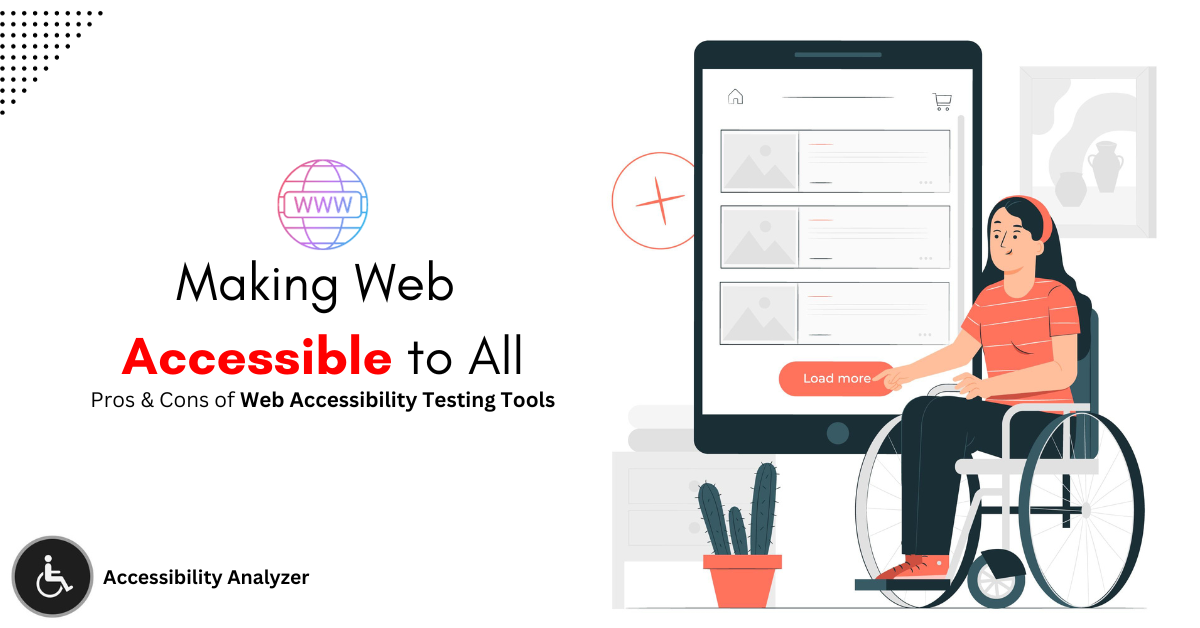In an era where the digital landscape is continually evolving, ensuring your website is accessible to everyone is important. Web accessibility testing tools have become indispensable for developers, designers, and businesses aiming to create an inclusive online environment. This blog post explores the pros and cons of various testing tools, with a special focus on the Accessibility Analyzer. By examining facts and figures, we aim to assist users in making an informed decision when choosing a web accessibility testing tool.
Understanding Web Accessibility
Web accessibility refers to the practice of ensuring that websites and web applications are usable by individuals with disabilities. This inclusivity extends to people with various impairments, including visual, auditory, cognitive, and motor disabilities. Accessibility testing tools play a crucial role in identifying and rectifying potential barriers to a seamless online experience for all users.
Web accessibility is not merely a compliance checkbox; it is a commitment to inclusivity, a gateway to a digital realm where everyone, regardless of their abilities or disabilities, can navigate, interact, and glean information seamlessly. At its core, web accessibility seeks to break down barriers that individuals with diverse impairments might encounter while engaging with online content.
The Role of Accessibility Testing Tools
Web Accessibility testing tools act as vigilant gatekeepers, scrutinizing websites and web applications to identify potential obstacles that could impede a smooth user experience. These tools automate the evaluation of digital content against established accessibility standards, such as the Web Content Accessibility Guidelines (WCAG).
By employing these tools, developers and designers can uncover issues related to contrast ratios, keyboard navigation, form elements, and more. This proactive approach not only ensures compliance with legal requirements but also fosters a culture of empathy and inclusivity in the digital landscape.
Popular Web Accessibility Testing Tools
1. Accessibility Analyzer
Pros:
- Robust Testing Capabilities: The Accessibility Analyzer boasts a comprehensive set of testing capabilities, covering a wide range of accessibility standards, including WCAG (Web Content Accessibility Guidelines).
- Automated Testing: The tool’s automation features empower developers to integrate accessibility testing seamlessly into their development workflows, catching issues early in the process.
- Integration Options: The Accessibility Analyzer seamlessly integrates with popular development environments and CI/CD pipelines, facilitating accessibility testing in the development lifecycle.
Cons:
- Learning Curve: Some users may experience a learning curve when getting acquainted with the tool’s advanced features and settings.
- Cost: While Accessibility Analyzer offers a free version, the full suite of features may require a subscription, which could be a drawback for budget-conscious users.
2. Axe Accessibility
Pros:
- Open Source: axe Accessibility is an open-source tool, making it accessible to a broad user base.
- Browser Extensions: The tool offers browser extensions for Chrome and Firefox, simplifying the testing process for developers.
- Community Support: Being open source, axe Accessibility benefits from a large and active community, providing support and continuous improvement.
Cons:
- Limited Automated Testing: While the Axe web accessibility testing tool provides automated testing, some users find it to be less extensive compared to other tools like the Accessibility Analyzer.
- User Interface Complexity: The interface might be overwhelming for beginners, requiring a bit of time to become familiar with its functionalities.
Conclusion
Choosing the right web accessibility testing tool is a critical decision in the development process. Accessibility Analyzer stands out as a reliable option, offering robust testing capabilities, automated features, and seamless integration options. While there may be a learning curve and associated costs, the benefits in terms of comprehensive accessibility testing make it a valuable investment for creating inclusive online experiences. Ultimately, the choice depends on the specific needs and preferences of the user or development team. With the right testing tool, we can collectively contribute to a more accessible and inclusive digital landscape.



